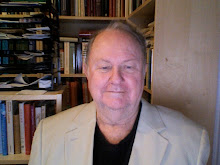Returning to two key figures discussed last time, Monet and Kandinsky, we find that a further contextualization dissolves the sense of iconographical arbitrariness, showing that, instead of pursuing mere personal penchants, these painters were responding to currents vital in their time.
In keeping with the Enlightenment disparagement of all things medieval, the French Revolution had treated the country's venerable monuments harshly--necessitating major restorations after the tide had turned. A telling document in the turn towards a renewed appreciation of the medieval contribution was Chateaubriand's "Genie du Christianisme" (1802), wherein he supported the forest theory of the origin of Gothic churches. Even more influential was Victor Hugo's novel "Notre Dame" of 1831. Setting his narrative at the very end of the Middle Ages, Hugo limned the Parisian cathedral as the mastertrope of a whole civilization. It stood on the verge of yielding to a new mastertrope, Gutenberg's printed book. Gradually a kind of cathedral-mania ensued in France, abetted by the 1842 revelation that the Gothic had in fact originated in that country (and not in Germany as had been previously thought--cf. Vasari's jibes). The enthusiasm generated one of the rare masterpieces of art-historical writing, Emile Male's "Gothic Image" (French original, 1898). Thus Monet's 31 love-letters to Rouen cathedral appeared at the culmination of a trend that had occupied four generations.
Kandinsky's excursions into Old Russia must be viewed in the light of Pan-Slavism, originating in the Prague Congress of 1848. At first primarily political (envisaging a series of national-liberation efforts), the trend came to emphasize the cultural distinctiveness of the Slavic peoples (Slavophilia). In Kandinsky's case this interest morphed into a concern with apocalyptic imagery (with both Eastern and Western roots), leading directly to his espousal of nonobjectivity. As with Monet the trajectory shows an inner logic, not a first suspected.
What is the Middle Ages? Is it truly a stable concept? The theme of fluctuating reputations can be seen in the changing reception of the work of Bosch and El Greco. The reputations of these two painters fell sharply at the time of their deaths, only to climb meteorically at the end of the 19th century. Today we admire the "real" Bosch and El Greco--but can we be sure? Eras also may suffer wholesale disparagement, witness 16th-century Mannerism and the Middle Ages.
As a synecdoche for the whole Middle Ages, the term Gothic merits close scrutiny. The Goths were a Germanic people that ravaged the Roman empire, starting in the 370s. By the 1140s, the birth date of what we know as Gothic architecture, the Goths had long disappeared as a distinct ethnic group. But the misnomer retained its appeal because of its aura of barbarism and bad taste. The disparagement prevalent in Early Modern Europe was only occasionally relieved by encomia of "Gothic balance," a free political system ostensibly introduced into England by the migrating Anglo-Saxons.
At first seemingly a neutral chronological marker, the term Middle Ages quickly took on negative connotations as the era was badmouthed as the "Dark Ages." We noted Vasari's 1550 harangue of the unnatural barbarism of the hated maniera tedesca. The religious reformers Luther and Calvin probably delivered more decisive blows. Calvinism adopted iconoclasm, physically annihilating mucy medieval sculpture and painting. As a via media Anglicanism was more tolerant.
In my view Chris Brooks' outstanding treatment of the cultivation of the "old style" in England cannot be bettered. Using the examples of Hagley Park and Nymphenburg we briefly alluded to the phenomenon of fake ruins in the 18th century. The third lecture will offer further reflections on the fascination with ruins.
Sunday, September 9, 2007
Subscribe to:
Post Comments (Atom)

No comments:
Post a Comment